Unilever's Logistics: Circular Economy, Industry 4.0, and COVID-19
VerifiedAdded on 2023/06/15
|12
|3937
|171
Report
AI Summary
This report provides a critical review of Unilever's global logistics operations, examining both inbound and outbound logistics networks and the impact of the COVID-19 pandemic. It analyzes how Unilever managed the pandemic's effects and made its logistics network less vulnerable. The report also explores how Unilever, along with its intermediaries, co-creates and adds value to its logistics operations while optimizing costs. Furthermore, it discusses improvements to the marketing channel network through technology and key lessons learned from the pandemic. Finally, it touches upon aligning the circular economy and Industry 4.0 to improve supply chain dimensions and operational decisions using innovation-led approaches.
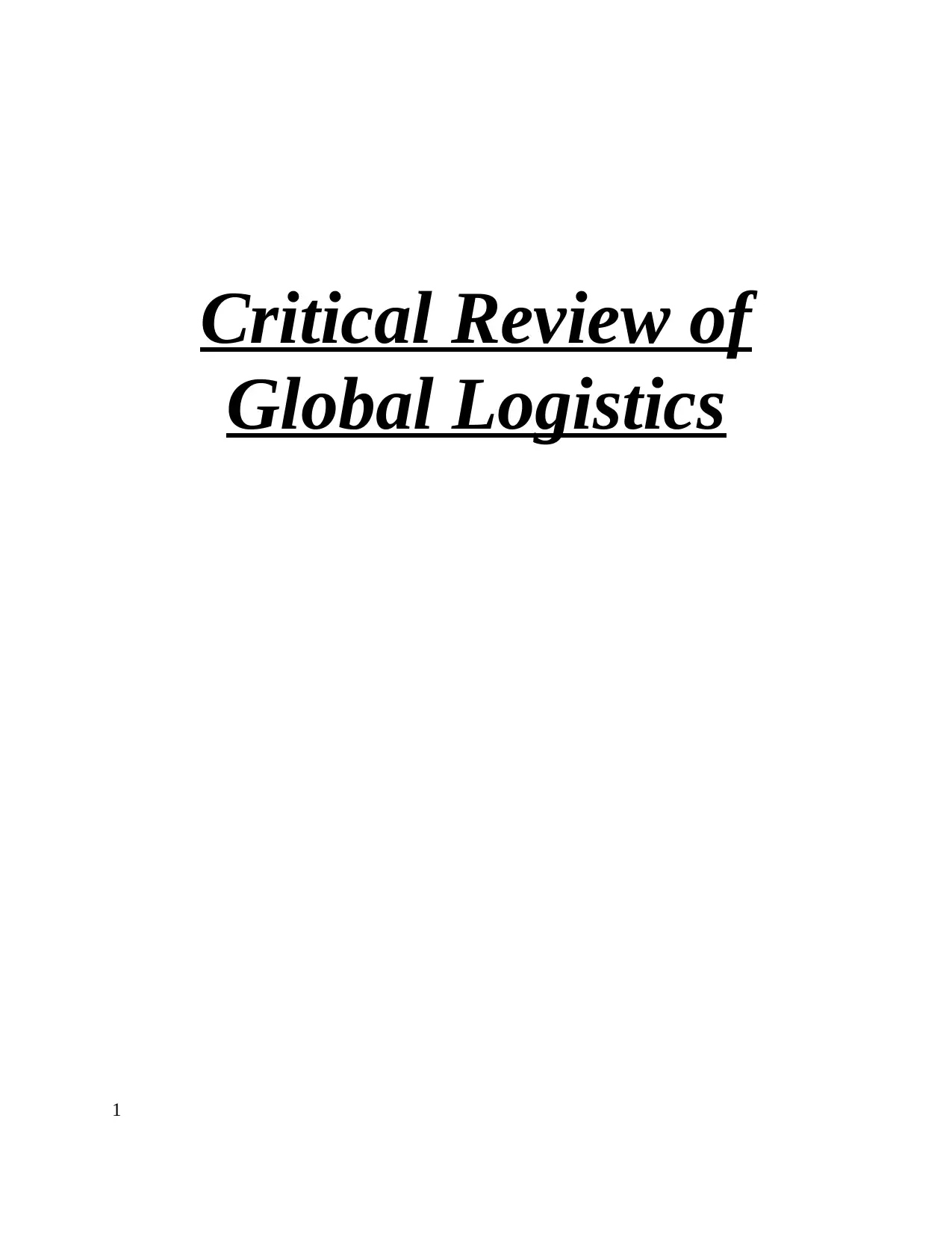
Critical Review of
Global Logistics
1
Global Logistics
1
Paraphrase This Document
Need a fresh take? Get an instant paraphrase of this document with our AI Paraphraser
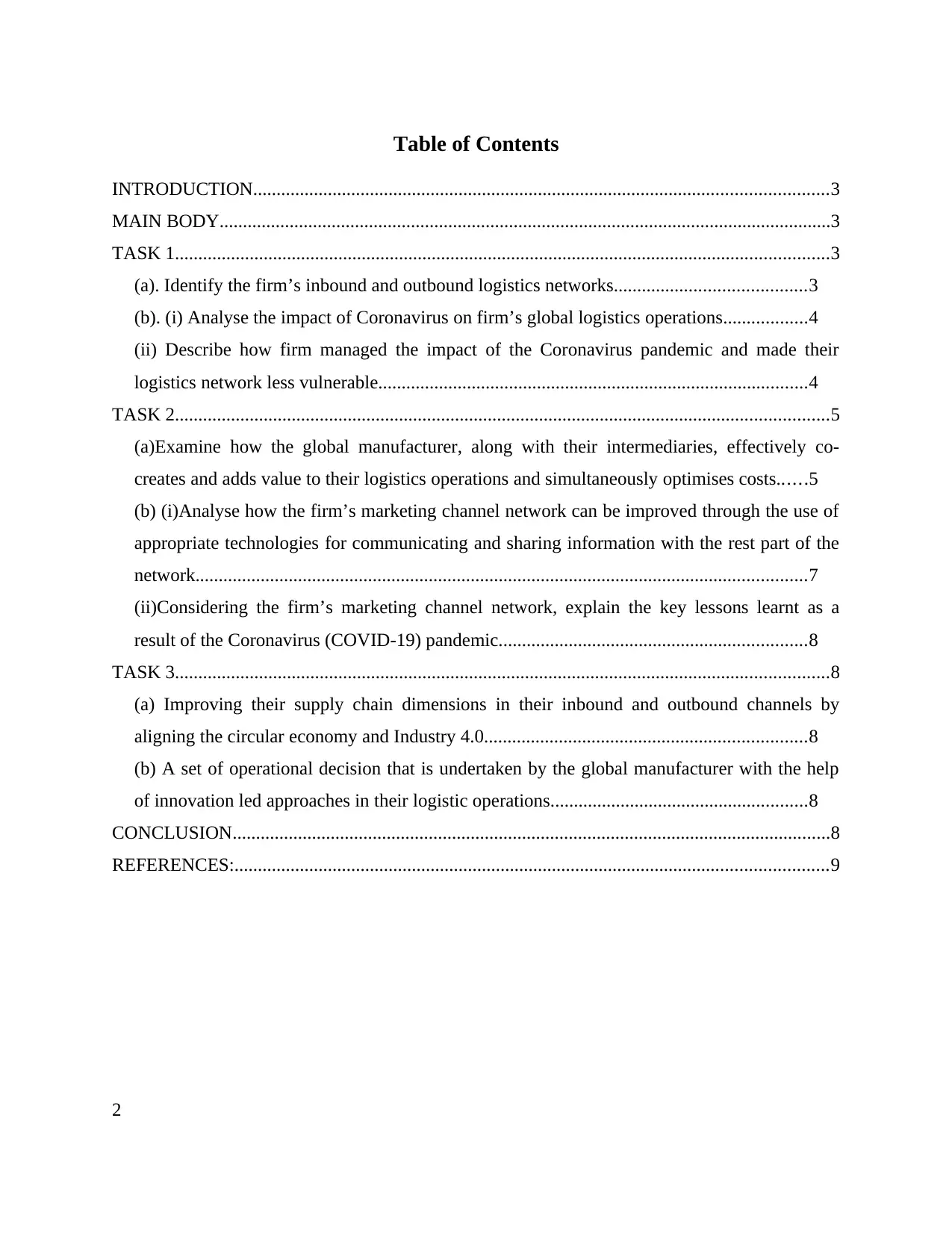
Table of Contents
INTRODUCTION...........................................................................................................................3
MAIN BODY...................................................................................................................................3
TASK 1............................................................................................................................................3
(a). Identify the firm’s inbound and outbound logistics networks.........................................3
(b). (i) Analyse the impact of Coronavirus on firm’s global logistics operations..................4
(ii) Describe how firm managed the impact of the Coronavirus pandemic and made their
logistics network less vulnerable............................................................................................4
TASK 2............................................................................................................................................5
(a)Examine how the global manufacturer, along with their intermediaries, effectively co-
creates and adds value to their logistics operations and simultaneously optimises costs......5
(b) (i)Analyse how the firm’s marketing channel network can be improved through the use of
appropriate technologies for communicating and sharing information with the rest part of the
network...................................................................................................................................7
(ii)Considering the firm’s marketing channel network, explain the key lessons learnt as a
result of the Coronavirus (COVID-19) pandemic..................................................................8
TASK 3............................................................................................................................................8
(a) Improving their supply chain dimensions in their inbound and outbound channels by
aligning the circular economy and Industry 4.0.....................................................................8
(b) A set of operational decision that is undertaken by the global manufacturer with the help
of innovation led approaches in their logistic operations.......................................................8
CONCLUSION................................................................................................................................8
REFERENCES:...............................................................................................................................9
2
INTRODUCTION...........................................................................................................................3
MAIN BODY...................................................................................................................................3
TASK 1............................................................................................................................................3
(a). Identify the firm’s inbound and outbound logistics networks.........................................3
(b). (i) Analyse the impact of Coronavirus on firm’s global logistics operations..................4
(ii) Describe how firm managed the impact of the Coronavirus pandemic and made their
logistics network less vulnerable............................................................................................4
TASK 2............................................................................................................................................5
(a)Examine how the global manufacturer, along with their intermediaries, effectively co-
creates and adds value to their logistics operations and simultaneously optimises costs......5
(b) (i)Analyse how the firm’s marketing channel network can be improved through the use of
appropriate technologies for communicating and sharing information with the rest part of the
network...................................................................................................................................7
(ii)Considering the firm’s marketing channel network, explain the key lessons learnt as a
result of the Coronavirus (COVID-19) pandemic..................................................................8
TASK 3............................................................................................................................................8
(a) Improving their supply chain dimensions in their inbound and outbound channels by
aligning the circular economy and Industry 4.0.....................................................................8
(b) A set of operational decision that is undertaken by the global manufacturer with the help
of innovation led approaches in their logistic operations.......................................................8
CONCLUSION................................................................................................................................8
REFERENCES:...............................................................................................................................9
2
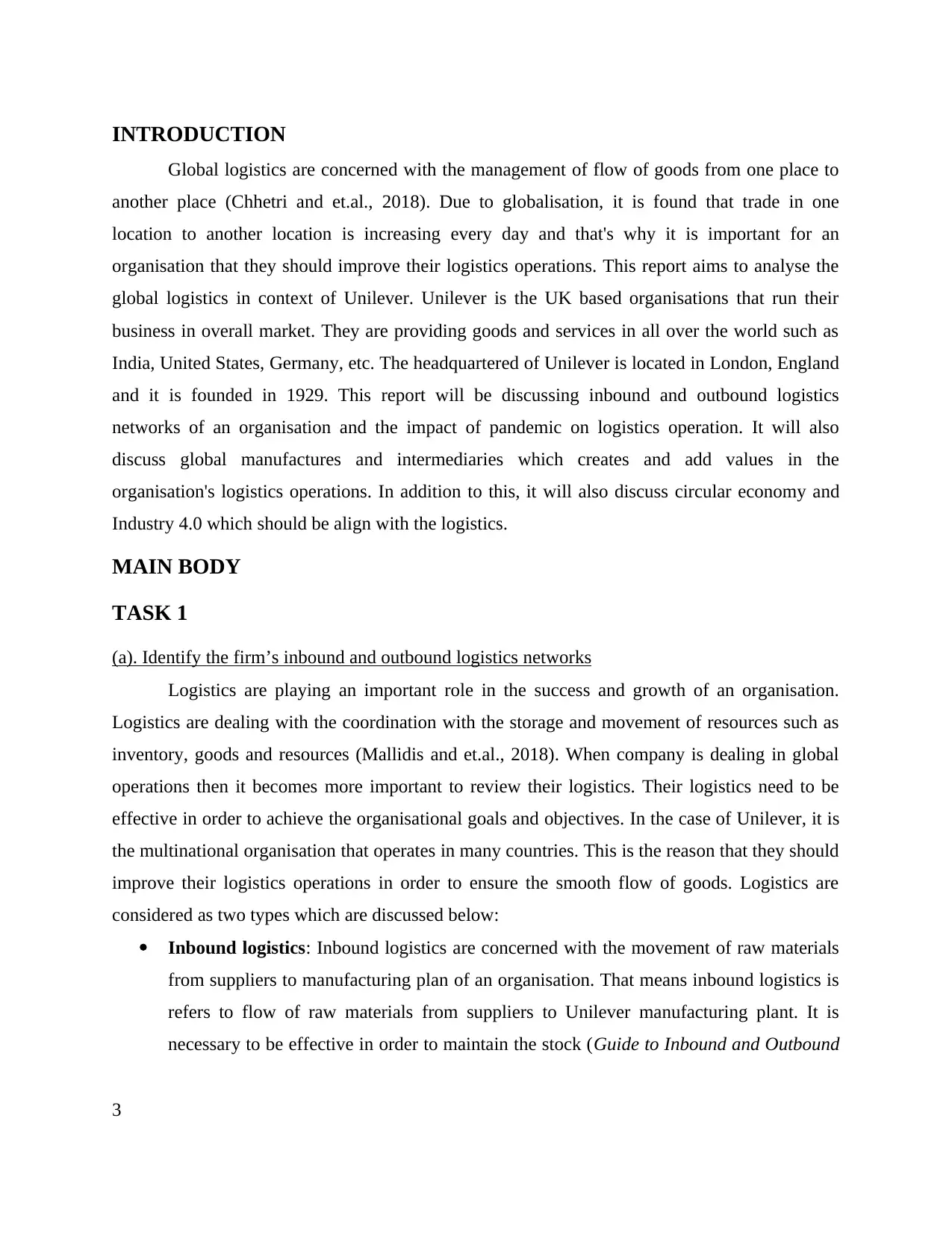
INTRODUCTION
Global logistics are concerned with the management of flow of goods from one place to
another place (Chhetri and et.al., 2018). Due to globalisation, it is found that trade in one
location to another location is increasing every day and that's why it is important for an
organisation that they should improve their logistics operations. This report aims to analyse the
global logistics in context of Unilever. Unilever is the UK based organisations that run their
business in overall market. They are providing goods and services in all over the world such as
India, United States, Germany, etc. The headquartered of Unilever is located in London, England
and it is founded in 1929. This report will be discussing inbound and outbound logistics
networks of an organisation and the impact of pandemic on logistics operation. It will also
discuss global manufactures and intermediaries which creates and add values in the
organisation's logistics operations. In addition to this, it will also discuss circular economy and
Industry 4.0 which should be align with the logistics.
MAIN BODY
TASK 1
(a). Identify the firm’s inbound and outbound logistics networks
Logistics are playing an important role in the success and growth of an organisation.
Logistics are dealing with the coordination with the storage and movement of resources such as
inventory, goods and resources (Mallidis and et.al., 2018). When company is dealing in global
operations then it becomes more important to review their logistics. Their logistics need to be
effective in order to achieve the organisational goals and objectives. In the case of Unilever, it is
the multinational organisation that operates in many countries. This is the reason that they should
improve their logistics operations in order to ensure the smooth flow of goods. Logistics are
considered as two types which are discussed below:
Inbound logistics: Inbound logistics are concerned with the movement of raw materials
from suppliers to manufacturing plan of an organisation. That means inbound logistics is
refers to flow of raw materials from suppliers to Unilever manufacturing plant. It is
necessary to be effective in order to maintain the stock (Guide to Inbound and Outbound
3
Global logistics are concerned with the management of flow of goods from one place to
another place (Chhetri and et.al., 2018). Due to globalisation, it is found that trade in one
location to another location is increasing every day and that's why it is important for an
organisation that they should improve their logistics operations. This report aims to analyse the
global logistics in context of Unilever. Unilever is the UK based organisations that run their
business in overall market. They are providing goods and services in all over the world such as
India, United States, Germany, etc. The headquartered of Unilever is located in London, England
and it is founded in 1929. This report will be discussing inbound and outbound logistics
networks of an organisation and the impact of pandemic on logistics operation. It will also
discuss global manufactures and intermediaries which creates and add values in the
organisation's logistics operations. In addition to this, it will also discuss circular economy and
Industry 4.0 which should be align with the logistics.
MAIN BODY
TASK 1
(a). Identify the firm’s inbound and outbound logistics networks
Logistics are playing an important role in the success and growth of an organisation.
Logistics are dealing with the coordination with the storage and movement of resources such as
inventory, goods and resources (Mallidis and et.al., 2018). When company is dealing in global
operations then it becomes more important to review their logistics. Their logistics need to be
effective in order to achieve the organisational goals and objectives. In the case of Unilever, it is
the multinational organisation that operates in many countries. This is the reason that they should
improve their logistics operations in order to ensure the smooth flow of goods. Logistics are
considered as two types which are discussed below:
Inbound logistics: Inbound logistics are concerned with the movement of raw materials
from suppliers to manufacturing plan of an organisation. That means inbound logistics is
refers to flow of raw materials from suppliers to Unilever manufacturing plant. It is
necessary to be effective in order to maintain the stock (Guide to Inbound and Outbound
3
⊘ This is a preview!⊘
Do you want full access?
Subscribe today to unlock all pages.

Trusted by 1+ million students worldwide
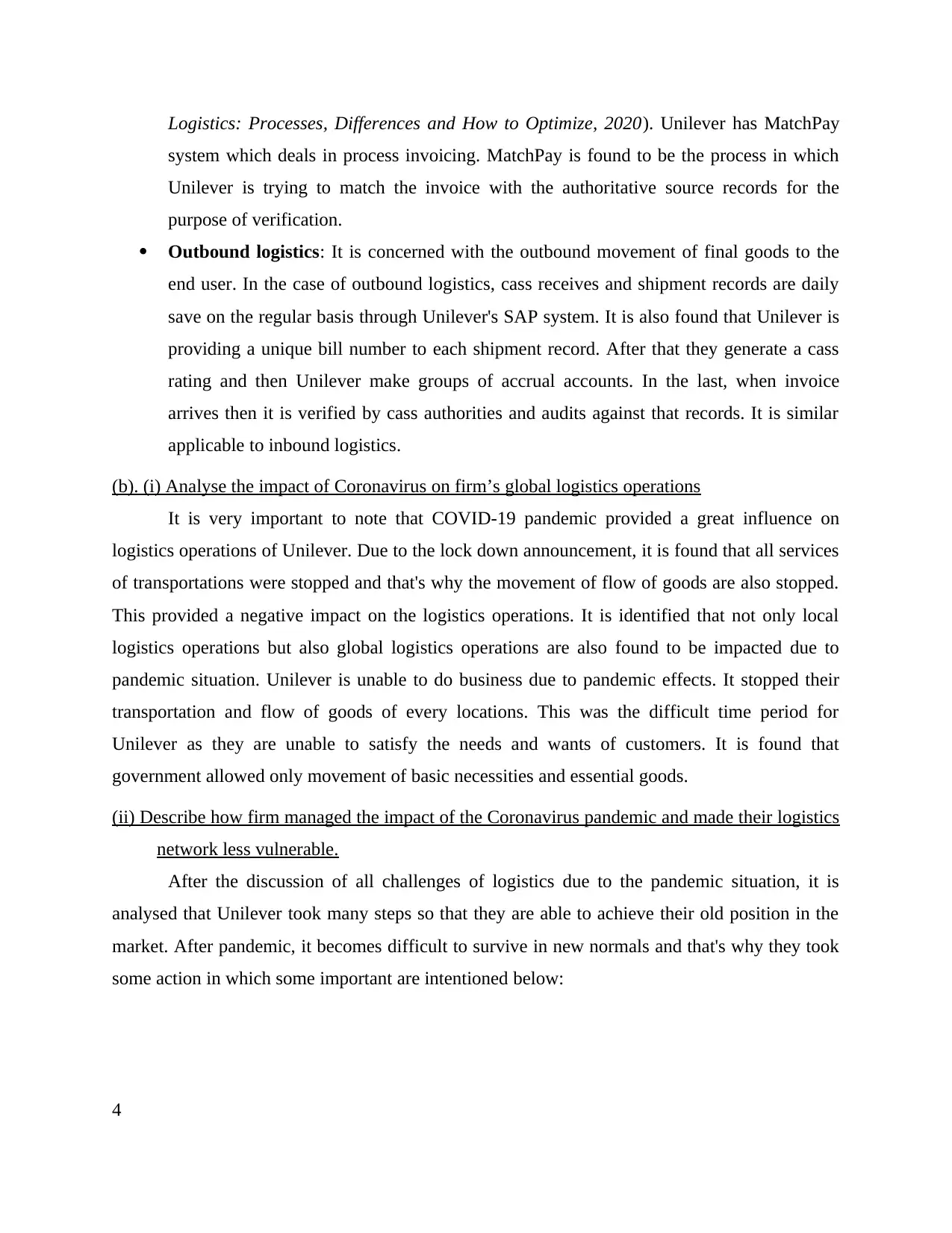
Logistics: Processes, Differences and How to Optimize, 2020). Unilever has MatchPay
system which deals in process invoicing. MatchPay is found to be the process in which
Unilever is trying to match the invoice with the authoritative source records for the
purpose of verification.
Outbound logistics: It is concerned with the outbound movement of final goods to the
end user. In the case of outbound logistics, cass receives and shipment records are daily
save on the regular basis through Unilever's SAP system. It is also found that Unilever is
providing a unique bill number to each shipment record. After that they generate a cass
rating and then Unilever make groups of accrual accounts. In the last, when invoice
arrives then it is verified by cass authorities and audits against that records. It is similar
applicable to inbound logistics.
(b). (i) Analyse the impact of Coronavirus on firm’s global logistics operations
It is very important to note that COVID-19 pandemic provided a great influence on
logistics operations of Unilever. Due to the lock down announcement, it is found that all services
of transportations were stopped and that's why the movement of flow of goods are also stopped.
This provided a negative impact on the logistics operations. It is identified that not only local
logistics operations but also global logistics operations are also found to be impacted due to
pandemic situation. Unilever is unable to do business due to pandemic effects. It stopped their
transportation and flow of goods of every locations. This was the difficult time period for
Unilever as they are unable to satisfy the needs and wants of customers. It is found that
government allowed only movement of basic necessities and essential goods.
(ii) Describe how firm managed the impact of the Coronavirus pandemic and made their logistics
network less vulnerable.
After the discussion of all challenges of logistics due to the pandemic situation, it is
analysed that Unilever took many steps so that they are able to achieve their old position in the
market. After pandemic, it becomes difficult to survive in new normals and that's why they took
some action in which some important are intentioned below:
4
system which deals in process invoicing. MatchPay is found to be the process in which
Unilever is trying to match the invoice with the authoritative source records for the
purpose of verification.
Outbound logistics: It is concerned with the outbound movement of final goods to the
end user. In the case of outbound logistics, cass receives and shipment records are daily
save on the regular basis through Unilever's SAP system. It is also found that Unilever is
providing a unique bill number to each shipment record. After that they generate a cass
rating and then Unilever make groups of accrual accounts. In the last, when invoice
arrives then it is verified by cass authorities and audits against that records. It is similar
applicable to inbound logistics.
(b). (i) Analyse the impact of Coronavirus on firm’s global logistics operations
It is very important to note that COVID-19 pandemic provided a great influence on
logistics operations of Unilever. Due to the lock down announcement, it is found that all services
of transportations were stopped and that's why the movement of flow of goods are also stopped.
This provided a negative impact on the logistics operations. It is identified that not only local
logistics operations but also global logistics operations are also found to be impacted due to
pandemic situation. Unilever is unable to do business due to pandemic effects. It stopped their
transportation and flow of goods of every locations. This was the difficult time period for
Unilever as they are unable to satisfy the needs and wants of customers. It is found that
government allowed only movement of basic necessities and essential goods.
(ii) Describe how firm managed the impact of the Coronavirus pandemic and made their logistics
network less vulnerable.
After the discussion of all challenges of logistics due to the pandemic situation, it is
analysed that Unilever took many steps so that they are able to achieve their old position in the
market. After pandemic, it becomes difficult to survive in new normals and that's why they took
some action in which some important are intentioned below:
4
Paraphrase This Document
Need a fresh take? Get an instant paraphrase of this document with our AI Paraphraser

It is identified that Unilever adopted product mix so that they are able to improve their
logistics operations (Unilever adapts product mix, supply chain to deliver surprise H1'20
results, 2020).
It is also found that Unilever has signed a Memorandum of Understanding in order to
drive sustainable business initiatives in their supply chain. It is very important for an
organisation that they needs to improve their logistics so that they can achieve the goals
and objectives. This actions helps an organisation to improve their operations of logistics
as they get assistance of largest China's retailers.
It is found that Unilever is increasing their supply chain capacity so that they are able to
overcome with the upcoming challenges of pandemic. It is also found that they are
already started a preparation of 3rd wave of pandemic (Supply chain ramped, adding
alternate sources: HUL is prepared for 3rd wave, 2021). This steps shows that how they
are actively participated in order to combat with the challenges.
These steps are very helpful for organisations as it helps them to reduce the complexities
of an organisation in terms of logistics. They are able to manage the logistics as well as make
their logistics less vulnerable. In this discussion, it is found that Unilever is able to achieve their
goals and objectives and try to make their logistics smooth.
TASK 2
(a)Examine how the global manufacturer, along with their intermediaries, effectively co-creates
and adds value to their logistics operations and simultaneously optimises costs.
In the global logistics management there is the role of wo parties that is global manufacturer and
their intermediaries. In case of the Unilever the company itself is the global manufacturer and the
other suppliers and small firms and start- ups linked with the logistics of the company are termed
as the intermediaries (Shah, Rutherford and Menon, 2020).
The global manufacturer is the organisation that performs the series of activities like
manufacturing of the components, sub elements and finished product for the another company by
utilizi8ng the raw materials, cost, manufacturing capabilities and most importantly the effective
supply chain that can move across the world. Unilever is the global manufacture that
manufactures the products for different brands like Dove, Santoor, Ponds etc.
5
logistics operations (Unilever adapts product mix, supply chain to deliver surprise H1'20
results, 2020).
It is also found that Unilever has signed a Memorandum of Understanding in order to
drive sustainable business initiatives in their supply chain. It is very important for an
organisation that they needs to improve their logistics so that they can achieve the goals
and objectives. This actions helps an organisation to improve their operations of logistics
as they get assistance of largest China's retailers.
It is found that Unilever is increasing their supply chain capacity so that they are able to
overcome with the upcoming challenges of pandemic. It is also found that they are
already started a preparation of 3rd wave of pandemic (Supply chain ramped, adding
alternate sources: HUL is prepared for 3rd wave, 2021). This steps shows that how they
are actively participated in order to combat with the challenges.
These steps are very helpful for organisations as it helps them to reduce the complexities
of an organisation in terms of logistics. They are able to manage the logistics as well as make
their logistics less vulnerable. In this discussion, it is found that Unilever is able to achieve their
goals and objectives and try to make their logistics smooth.
TASK 2
(a)Examine how the global manufacturer, along with their intermediaries, effectively co-creates
and adds value to their logistics operations and simultaneously optimises costs.
In the global logistics management there is the role of wo parties that is global manufacturer and
their intermediaries. In case of the Unilever the company itself is the global manufacturer and the
other suppliers and small firms and start- ups linked with the logistics of the company are termed
as the intermediaries (Shah, Rutherford and Menon, 2020).
The global manufacturer is the organisation that performs the series of activities like
manufacturing of the components, sub elements and finished product for the another company by
utilizi8ng the raw materials, cost, manufacturing capabilities and most importantly the effective
supply chain that can move across the world. Unilever is the global manufacture that
manufactures the products for different brands like Dove, Santoor, Ponds etc.
5
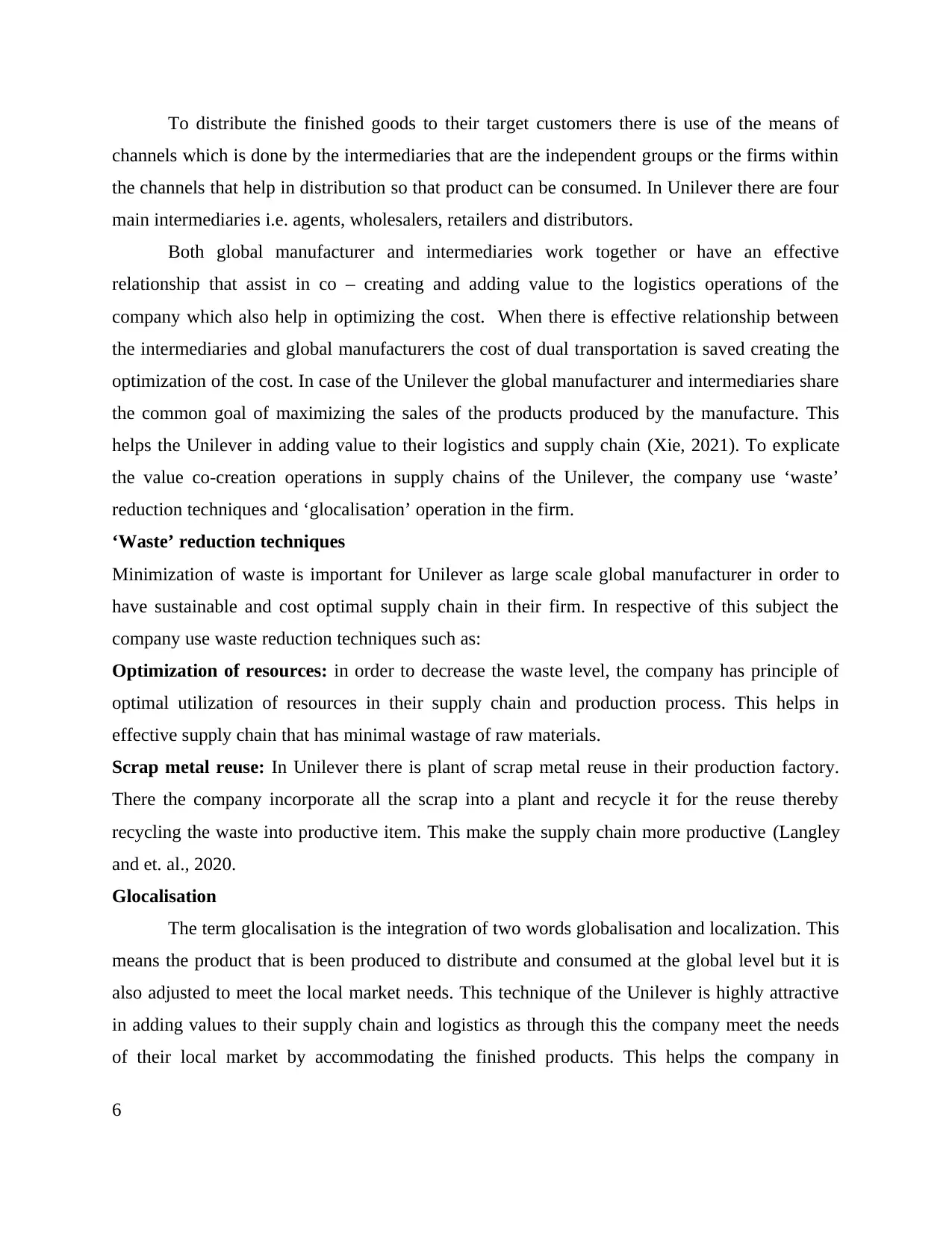
To distribute the finished goods to their target customers there is use of the means of
channels which is done by the intermediaries that are the independent groups or the firms within
the channels that help in distribution so that product can be consumed. In Unilever there are four
main intermediaries i.e. agents, wholesalers, retailers and distributors.
Both global manufacturer and intermediaries work together or have an effective
relationship that assist in co – creating and adding value to the logistics operations of the
company which also help in optimizing the cost. When there is effective relationship between
the intermediaries and global manufacturers the cost of dual transportation is saved creating the
optimization of the cost. In case of the Unilever the global manufacturer and intermediaries share
the common goal of maximizing the sales of the products produced by the manufacture. This
helps the Unilever in adding value to their logistics and supply chain (Xie, 2021). To explicate
the value co-creation operations in supply chains of the Unilever, the company use ‘waste’
reduction techniques and ‘glocalisation’ operation in the firm.
‘Waste’ reduction techniques
Minimization of waste is important for Unilever as large scale global manufacturer in order to
have sustainable and cost optimal supply chain in their firm. In respective of this subject the
company use waste reduction techniques such as:
Optimization of resources: in order to decrease the waste level, the company has principle of
optimal utilization of resources in their supply chain and production process. This helps in
effective supply chain that has minimal wastage of raw materials.
Scrap metal reuse: In Unilever there is plant of scrap metal reuse in their production factory.
There the company incorporate all the scrap into a plant and recycle it for the reuse thereby
recycling the waste into productive item. This make the supply chain more productive (Langley
and et. al., 2020.
Glocalisation
The term glocalisation is the integration of two words globalisation and localization. This
means the product that is been produced to distribute and consumed at the global level but it is
also adjusted to meet the local market needs. This technique of the Unilever is highly attractive
in adding values to their supply chain and logistics as through this the company meet the needs
of their local market by accommodating the finished products. This helps the company in
6
channels which is done by the intermediaries that are the independent groups or the firms within
the channels that help in distribution so that product can be consumed. In Unilever there are four
main intermediaries i.e. agents, wholesalers, retailers and distributors.
Both global manufacturer and intermediaries work together or have an effective
relationship that assist in co – creating and adding value to the logistics operations of the
company which also help in optimizing the cost. When there is effective relationship between
the intermediaries and global manufacturers the cost of dual transportation is saved creating the
optimization of the cost. In case of the Unilever the global manufacturer and intermediaries share
the common goal of maximizing the sales of the products produced by the manufacture. This
helps the Unilever in adding value to their logistics and supply chain (Xie, 2021). To explicate
the value co-creation operations in supply chains of the Unilever, the company use ‘waste’
reduction techniques and ‘glocalisation’ operation in the firm.
‘Waste’ reduction techniques
Minimization of waste is important for Unilever as large scale global manufacturer in order to
have sustainable and cost optimal supply chain in their firm. In respective of this subject the
company use waste reduction techniques such as:
Optimization of resources: in order to decrease the waste level, the company has principle of
optimal utilization of resources in their supply chain and production process. This helps in
effective supply chain that has minimal wastage of raw materials.
Scrap metal reuse: In Unilever there is plant of scrap metal reuse in their production factory.
There the company incorporate all the scrap into a plant and recycle it for the reuse thereby
recycling the waste into productive item. This make the supply chain more productive (Langley
and et. al., 2020.
Glocalisation
The term glocalisation is the integration of two words globalisation and localization. This
means the product that is been produced to distribute and consumed at the global level but it is
also adjusted to meet the local market needs. This technique of the Unilever is highly attractive
in adding values to their supply chain and logistics as through this the company meet the needs
of their local market by accommodating the finished products. This helps the company in
6
⊘ This is a preview!⊘
Do you want full access?
Subscribe today to unlock all pages.

Trusted by 1+ million students worldwide
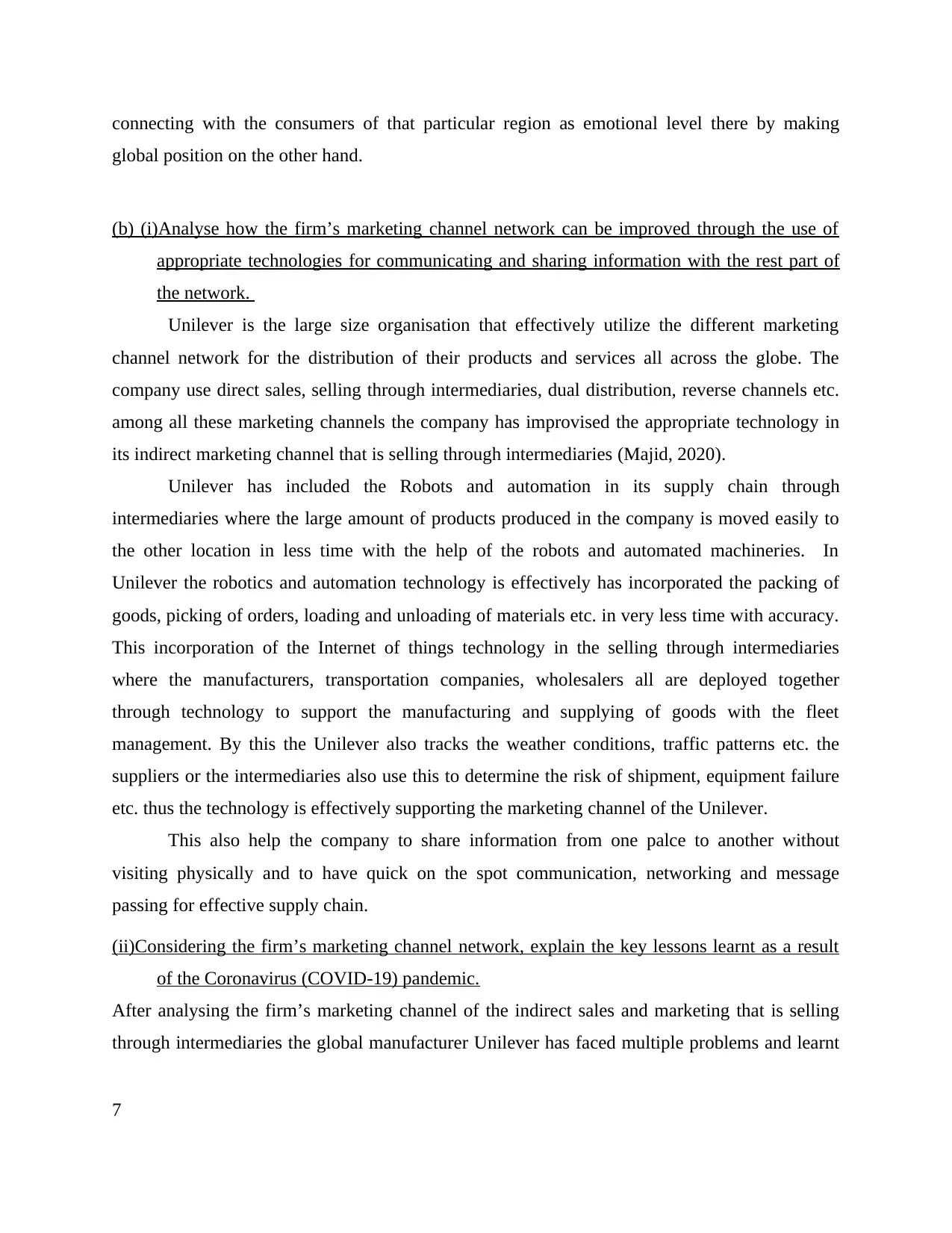
connecting with the consumers of that particular region as emotional level there by making
global position on the other hand.
(b) (i)Analyse how the firm’s marketing channel network can be improved through the use of
appropriate technologies for communicating and sharing information with the rest part of
the network.
Unilever is the large size organisation that effectively utilize the different marketing
channel network for the distribution of their products and services all across the globe. The
company use direct sales, selling through intermediaries, dual distribution, reverse channels etc.
among all these marketing channels the company has improvised the appropriate technology in
its indirect marketing channel that is selling through intermediaries (Majid, 2020).
Unilever has included the Robots and automation in its supply chain through
intermediaries where the large amount of products produced in the company is moved easily to
the other location in less time with the help of the robots and automated machineries. In
Unilever the robotics and automation technology is effectively has incorporated the packing of
goods, picking of orders, loading and unloading of materials etc. in very less time with accuracy.
This incorporation of the Internet of things technology in the selling through intermediaries
where the manufacturers, transportation companies, wholesalers all are deployed together
through technology to support the manufacturing and supplying of goods with the fleet
management. By this the Unilever also tracks the weather conditions, traffic patterns etc. the
suppliers or the intermediaries also use this to determine the risk of shipment, equipment failure
etc. thus the technology is effectively supporting the marketing channel of the Unilever.
This also help the company to share information from one palce to another without
visiting physically and to have quick on the spot communication, networking and message
passing for effective supply chain.
(ii)Considering the firm’s marketing channel network, explain the key lessons learnt as a result
of the Coronavirus (COVID-19) pandemic.
After analysing the firm’s marketing channel of the indirect sales and marketing that is selling
through intermediaries the global manufacturer Unilever has faced multiple problems and learnt
7
global position on the other hand.
(b) (i)Analyse how the firm’s marketing channel network can be improved through the use of
appropriate technologies for communicating and sharing information with the rest part of
the network.
Unilever is the large size organisation that effectively utilize the different marketing
channel network for the distribution of their products and services all across the globe. The
company use direct sales, selling through intermediaries, dual distribution, reverse channels etc.
among all these marketing channels the company has improvised the appropriate technology in
its indirect marketing channel that is selling through intermediaries (Majid, 2020).
Unilever has included the Robots and automation in its supply chain through
intermediaries where the large amount of products produced in the company is moved easily to
the other location in less time with the help of the robots and automated machineries. In
Unilever the robotics and automation technology is effectively has incorporated the packing of
goods, picking of orders, loading and unloading of materials etc. in very less time with accuracy.
This incorporation of the Internet of things technology in the selling through intermediaries
where the manufacturers, transportation companies, wholesalers all are deployed together
through technology to support the manufacturing and supplying of goods with the fleet
management. By this the Unilever also tracks the weather conditions, traffic patterns etc. the
suppliers or the intermediaries also use this to determine the risk of shipment, equipment failure
etc. thus the technology is effectively supporting the marketing channel of the Unilever.
This also help the company to share information from one palce to another without
visiting physically and to have quick on the spot communication, networking and message
passing for effective supply chain.
(ii)Considering the firm’s marketing channel network, explain the key lessons learnt as a result
of the Coronavirus (COVID-19) pandemic.
After analysing the firm’s marketing channel of the indirect sales and marketing that is selling
through intermediaries the global manufacturer Unilever has faced multiple problems and learnt
7
Paraphrase This Document
Need a fresh take? Get an instant paraphrase of this document with our AI Paraphraser
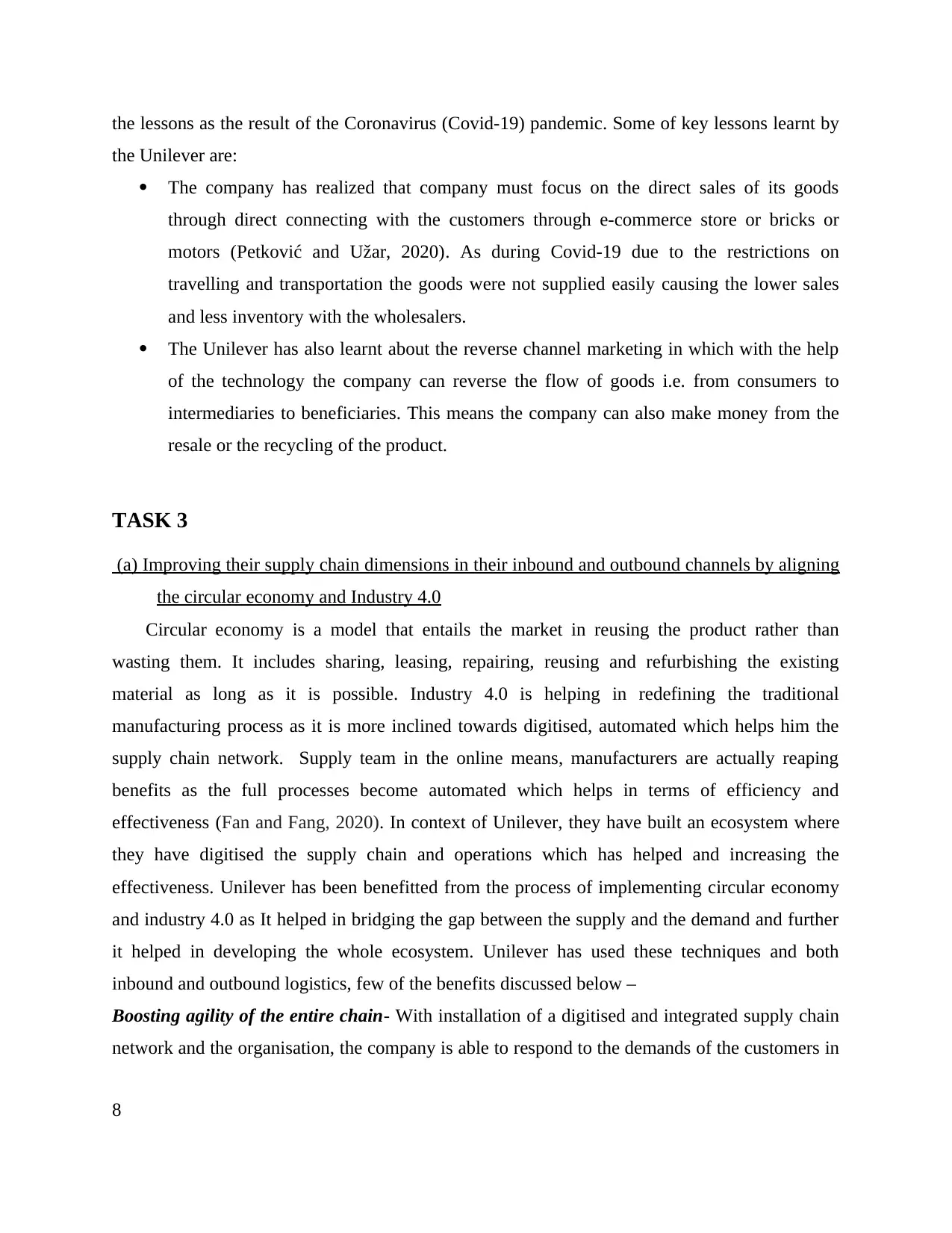
the lessons as the result of the Coronavirus (Covid-19) pandemic. Some of key lessons learnt by
the Unilever are:
The company has realized that company must focus on the direct sales of its goods
through direct connecting with the customers through e-commerce store or bricks or
motors (Petković and Užar, 2020). As during Covid-19 due to the restrictions on
travelling and transportation the goods were not supplied easily causing the lower sales
and less inventory with the wholesalers.
The Unilever has also learnt about the reverse channel marketing in which with the help
of the technology the company can reverse the flow of goods i.e. from consumers to
intermediaries to beneficiaries. This means the company can also make money from the
resale or the recycling of the product.
TASK 3
(a) Improving their supply chain dimensions in their inbound and outbound channels by aligning
the circular economy and Industry 4.0
Circular economy is a model that entails the market in reusing the product rather than
wasting them. It includes sharing, leasing, repairing, reusing and refurbishing the existing
material as long as it is possible. Industry 4.0 is helping in redefining the traditional
manufacturing process as it is more inclined towards digitised, automated which helps him the
supply chain network. Supply team in the online means, manufacturers are actually reaping
benefits as the full processes become automated which helps in terms of efficiency and
effectiveness (Fan and Fang, 2020). In context of Unilever, they have built an ecosystem where
they have digitised the supply chain and operations which has helped and increasing the
effectiveness. Unilever has been benefitted from the process of implementing circular economy
and industry 4.0 as It helped in bridging the gap between the supply and the demand and further
it helped in developing the whole ecosystem. Unilever has used these techniques and both
inbound and outbound logistics, few of the benefits discussed below –
Boosting agility of the entire chain- With installation of a digitised and integrated supply chain
network and the organisation, the company is able to respond to the demands of the customers in
8
the Unilever are:
The company has realized that company must focus on the direct sales of its goods
through direct connecting with the customers through e-commerce store or bricks or
motors (Petković and Užar, 2020). As during Covid-19 due to the restrictions on
travelling and transportation the goods were not supplied easily causing the lower sales
and less inventory with the wholesalers.
The Unilever has also learnt about the reverse channel marketing in which with the help
of the technology the company can reverse the flow of goods i.e. from consumers to
intermediaries to beneficiaries. This means the company can also make money from the
resale or the recycling of the product.
TASK 3
(a) Improving their supply chain dimensions in their inbound and outbound channels by aligning
the circular economy and Industry 4.0
Circular economy is a model that entails the market in reusing the product rather than
wasting them. It includes sharing, leasing, repairing, reusing and refurbishing the existing
material as long as it is possible. Industry 4.0 is helping in redefining the traditional
manufacturing process as it is more inclined towards digitised, automated which helps him the
supply chain network. Supply team in the online means, manufacturers are actually reaping
benefits as the full processes become automated which helps in terms of efficiency and
effectiveness (Fan and Fang, 2020). In context of Unilever, they have built an ecosystem where
they have digitised the supply chain and operations which has helped and increasing the
effectiveness. Unilever has been benefitted from the process of implementing circular economy
and industry 4.0 as It helped in bridging the gap between the supply and the demand and further
it helped in developing the whole ecosystem. Unilever has used these techniques and both
inbound and outbound logistics, few of the benefits discussed below –
Boosting agility of the entire chain- With installation of a digitised and integrated supply chain
network and the organisation, the company is able to respond to the demands of the customers in
8
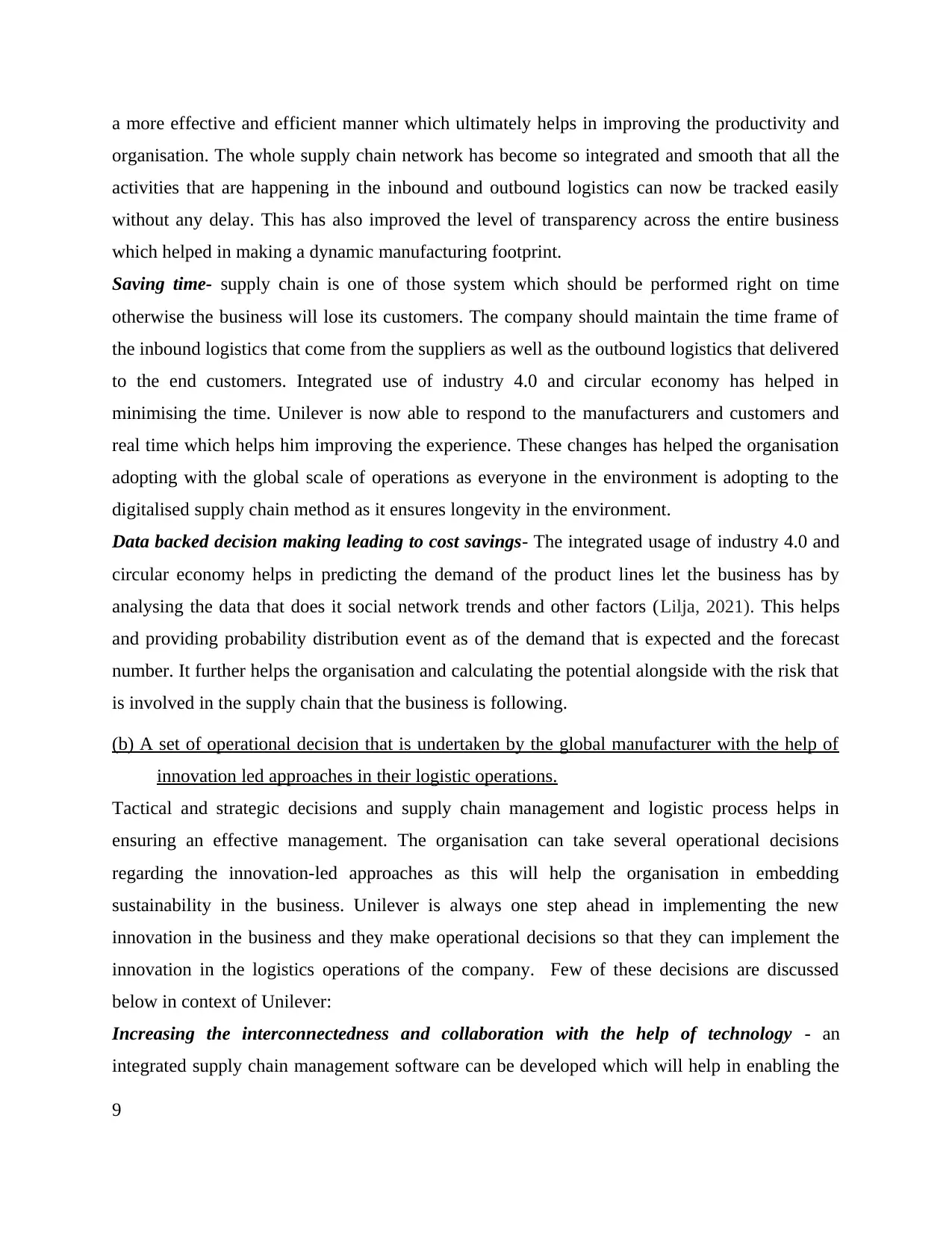
a more effective and efficient manner which ultimately helps in improving the productivity and
organisation. The whole supply chain network has become so integrated and smooth that all the
activities that are happening in the inbound and outbound logistics can now be tracked easily
without any delay. This has also improved the level of transparency across the entire business
which helped in making a dynamic manufacturing footprint.
Saving time- supply chain is one of those system which should be performed right on time
otherwise the business will lose its customers. The company should maintain the time frame of
the inbound logistics that come from the suppliers as well as the outbound logistics that delivered
to the end customers. Integrated use of industry 4.0 and circular economy has helped in
minimising the time. Unilever is now able to respond to the manufacturers and customers and
real time which helps him improving the experience. These changes has helped the organisation
adopting with the global scale of operations as everyone in the environment is adopting to the
digitalised supply chain method as it ensures longevity in the environment.
Data backed decision making leading to cost savings- The integrated usage of industry 4.0 and
circular economy helps in predicting the demand of the product lines let the business has by
analysing the data that does it social network trends and other factors (Lilja, 2021). This helps
and providing probability distribution event as of the demand that is expected and the forecast
number. It further helps the organisation and calculating the potential alongside with the risk that
is involved in the supply chain that the business is following.
(b) A set of operational decision that is undertaken by the global manufacturer with the help of
innovation led approaches in their logistic operations.
Tactical and strategic decisions and supply chain management and logistic process helps in
ensuring an effective management. The organisation can take several operational decisions
regarding the innovation-led approaches as this will help the organisation in embedding
sustainability in the business. Unilever is always one step ahead in implementing the new
innovation in the business and they make operational decisions so that they can implement the
innovation in the logistics operations of the company. Few of these decisions are discussed
below in context of Unilever:
Increasing the interconnectedness and collaboration with the help of technology - an
integrated supply chain management software can be developed which will help in enabling the
9
organisation. The whole supply chain network has become so integrated and smooth that all the
activities that are happening in the inbound and outbound logistics can now be tracked easily
without any delay. This has also improved the level of transparency across the entire business
which helped in making a dynamic manufacturing footprint.
Saving time- supply chain is one of those system which should be performed right on time
otherwise the business will lose its customers. The company should maintain the time frame of
the inbound logistics that come from the suppliers as well as the outbound logistics that delivered
to the end customers. Integrated use of industry 4.0 and circular economy has helped in
minimising the time. Unilever is now able to respond to the manufacturers and customers and
real time which helps him improving the experience. These changes has helped the organisation
adopting with the global scale of operations as everyone in the environment is adopting to the
digitalised supply chain method as it ensures longevity in the environment.
Data backed decision making leading to cost savings- The integrated usage of industry 4.0 and
circular economy helps in predicting the demand of the product lines let the business has by
analysing the data that does it social network trends and other factors (Lilja, 2021). This helps
and providing probability distribution event as of the demand that is expected and the forecast
number. It further helps the organisation and calculating the potential alongside with the risk that
is involved in the supply chain that the business is following.
(b) A set of operational decision that is undertaken by the global manufacturer with the help of
innovation led approaches in their logistic operations.
Tactical and strategic decisions and supply chain management and logistic process helps in
ensuring an effective management. The organisation can take several operational decisions
regarding the innovation-led approaches as this will help the organisation in embedding
sustainability in the business. Unilever is always one step ahead in implementing the new
innovation in the business and they make operational decisions so that they can implement the
innovation in the logistics operations of the company. Few of these decisions are discussed
below in context of Unilever:
Increasing the interconnectedness and collaboration with the help of technology - an
integrated supply chain management software can be developed which will help in enabling the
9
⊘ This is a preview!⊘
Do you want full access?
Subscribe today to unlock all pages.

Trusted by 1+ million students worldwide
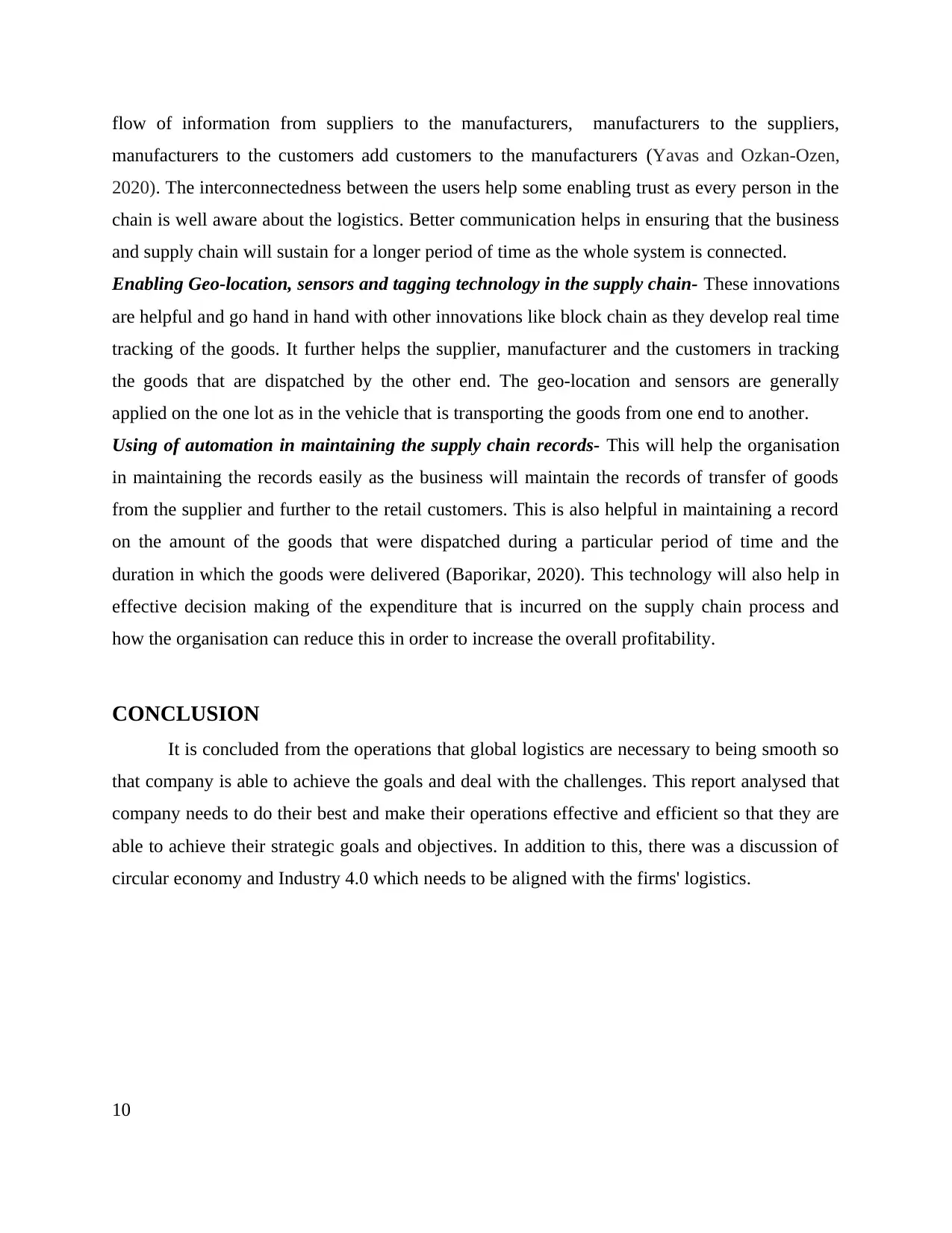
flow of information from suppliers to the manufacturers, manufacturers to the suppliers,
manufacturers to the customers add customers to the manufacturers (Yavas and Ozkan-Ozen,
2020). The interconnectedness between the users help some enabling trust as every person in the
chain is well aware about the logistics. Better communication helps in ensuring that the business
and supply chain will sustain for a longer period of time as the whole system is connected.
Enabling Geo-location, sensors and tagging technology in the supply chain- These innovations
are helpful and go hand in hand with other innovations like block chain as they develop real time
tracking of the goods. It further helps the supplier, manufacturer and the customers in tracking
the goods that are dispatched by the other end. The geo-location and sensors are generally
applied on the one lot as in the vehicle that is transporting the goods from one end to another.
Using of automation in maintaining the supply chain records- This will help the organisation
in maintaining the records easily as the business will maintain the records of transfer of goods
from the supplier and further to the retail customers. This is also helpful in maintaining a record
on the amount of the goods that were dispatched during a particular period of time and the
duration in which the goods were delivered (Baporikar, 2020). This technology will also help in
effective decision making of the expenditure that is incurred on the supply chain process and
how the organisation can reduce this in order to increase the overall profitability.
CONCLUSION
It is concluded from the operations that global logistics are necessary to being smooth so
that company is able to achieve the goals and deal with the challenges. This report analysed that
company needs to do their best and make their operations effective and efficient so that they are
able to achieve their strategic goals and objectives. In addition to this, there was a discussion of
circular economy and Industry 4.0 which needs to be aligned with the firms' logistics.
10
manufacturers to the customers add customers to the manufacturers (Yavas and Ozkan-Ozen,
2020). The interconnectedness between the users help some enabling trust as every person in the
chain is well aware about the logistics. Better communication helps in ensuring that the business
and supply chain will sustain for a longer period of time as the whole system is connected.
Enabling Geo-location, sensors and tagging technology in the supply chain- These innovations
are helpful and go hand in hand with other innovations like block chain as they develop real time
tracking of the goods. It further helps the supplier, manufacturer and the customers in tracking
the goods that are dispatched by the other end. The geo-location and sensors are generally
applied on the one lot as in the vehicle that is transporting the goods from one end to another.
Using of automation in maintaining the supply chain records- This will help the organisation
in maintaining the records easily as the business will maintain the records of transfer of goods
from the supplier and further to the retail customers. This is also helpful in maintaining a record
on the amount of the goods that were dispatched during a particular period of time and the
duration in which the goods were delivered (Baporikar, 2020). This technology will also help in
effective decision making of the expenditure that is incurred on the supply chain process and
how the organisation can reduce this in order to increase the overall profitability.
CONCLUSION
It is concluded from the operations that global logistics are necessary to being smooth so
that company is able to achieve the goals and deal with the challenges. This report analysed that
company needs to do their best and make their operations effective and efficient so that they are
able to achieve their strategic goals and objectives. In addition to this, there was a discussion of
circular economy and Industry 4.0 which needs to be aligned with the firms' logistics.
10
Paraphrase This Document
Need a fresh take? Get an instant paraphrase of this document with our AI Paraphraser

REFERENCES:
Books and Journals
Chhetri, P., and et.al., 2018. Global logistics city concept: a cluster-led strategy under the belt
and road initiative. Maritime Policy & Management, 45(3), pp.319-335.
Mallidis, I., and et.al., 2018. The impact of slow steaming on the carriers’ and shippers’ costs:
The case of a global logistics network. Transportation Research Part E: Logistics and
Transportation Review, 111, pp.18-39.
Langley, C.J and et. al., 2020. Supply chain management: a logistics perspective. Cengage
Learning.
Majid, K.A., 2020. Effect of interactive marketing channels on service customer
acquisition. Journal of Services Marketing.
Petković, G. and Užar, D., 2020. Marketing channels in value creation and delivery of cheese in
the Republic of Serbia. Anali Ekonomskog fakulteta u Subotici, 56(43), pp.101-115.
Baporikar, N., 2020. Logistics Effectiveness Through Systems Thinking. International Journal of
System Dynamics Applications (IJSDA), 9(2), pp.64-79.
Yavas, V. and Ozkan-Ozen, Y.D., 2020. Logistics centers in the new industrial era: A proposed
framework for logistics center 4.0. Transportation Research Part E: Logistics and
Transportation Review, 135, p.101864.
Lilja, T., 2021. Change management in digitalization of project logistics and implementation of a
new logistics management system.
Fan, Y. and Fang, C., 2020. Circular economy development in China-current situation,
evaluation and policy implications. Environmental Impact Assessment Review, 84,
p.106441.
Geissdoerfer, M and et. al., 2018. Business models and supply chains for the circular
economy. Journal of cleaner production, 190, pp.712-721.
Shah, S., Rutherford, R. and Menon, S., 2020, January. Emerging technologies of IoT usage in
global logistics. In 2020 International Conference on Computation, Automation and
Knowledge Management (ICCAKM) (pp. 251-257). IEEE.
Xie, M., 2021, August. Application and Exploration of Computer Technology In Modern
Enterprise Logistics Management. In Journal of Physics: Conference Series (Vol. 1992,
No. 3, p. 032061). IOP Publishing.
Online
11
Books and Journals
Chhetri, P., and et.al., 2018. Global logistics city concept: a cluster-led strategy under the belt
and road initiative. Maritime Policy & Management, 45(3), pp.319-335.
Mallidis, I., and et.al., 2018. The impact of slow steaming on the carriers’ and shippers’ costs:
The case of a global logistics network. Transportation Research Part E: Logistics and
Transportation Review, 111, pp.18-39.
Langley, C.J and et. al., 2020. Supply chain management: a logistics perspective. Cengage
Learning.
Majid, K.A., 2020. Effect of interactive marketing channels on service customer
acquisition. Journal of Services Marketing.
Petković, G. and Užar, D., 2020. Marketing channels in value creation and delivery of cheese in
the Republic of Serbia. Anali Ekonomskog fakulteta u Subotici, 56(43), pp.101-115.
Baporikar, N., 2020. Logistics Effectiveness Through Systems Thinking. International Journal of
System Dynamics Applications (IJSDA), 9(2), pp.64-79.
Yavas, V. and Ozkan-Ozen, Y.D., 2020. Logistics centers in the new industrial era: A proposed
framework for logistics center 4.0. Transportation Research Part E: Logistics and
Transportation Review, 135, p.101864.
Lilja, T., 2021. Change management in digitalization of project logistics and implementation of a
new logistics management system.
Fan, Y. and Fang, C., 2020. Circular economy development in China-current situation,
evaluation and policy implications. Environmental Impact Assessment Review, 84,
p.106441.
Geissdoerfer, M and et. al., 2018. Business models and supply chains for the circular
economy. Journal of cleaner production, 190, pp.712-721.
Shah, S., Rutherford, R. and Menon, S., 2020, January. Emerging technologies of IoT usage in
global logistics. In 2020 International Conference on Computation, Automation and
Knowledge Management (ICCAKM) (pp. 251-257). IEEE.
Xie, M., 2021, August. Application and Exploration of Computer Technology In Modern
Enterprise Logistics Management. In Journal of Physics: Conference Series (Vol. 1992,
No. 3, p. 032061). IOP Publishing.
Online
11
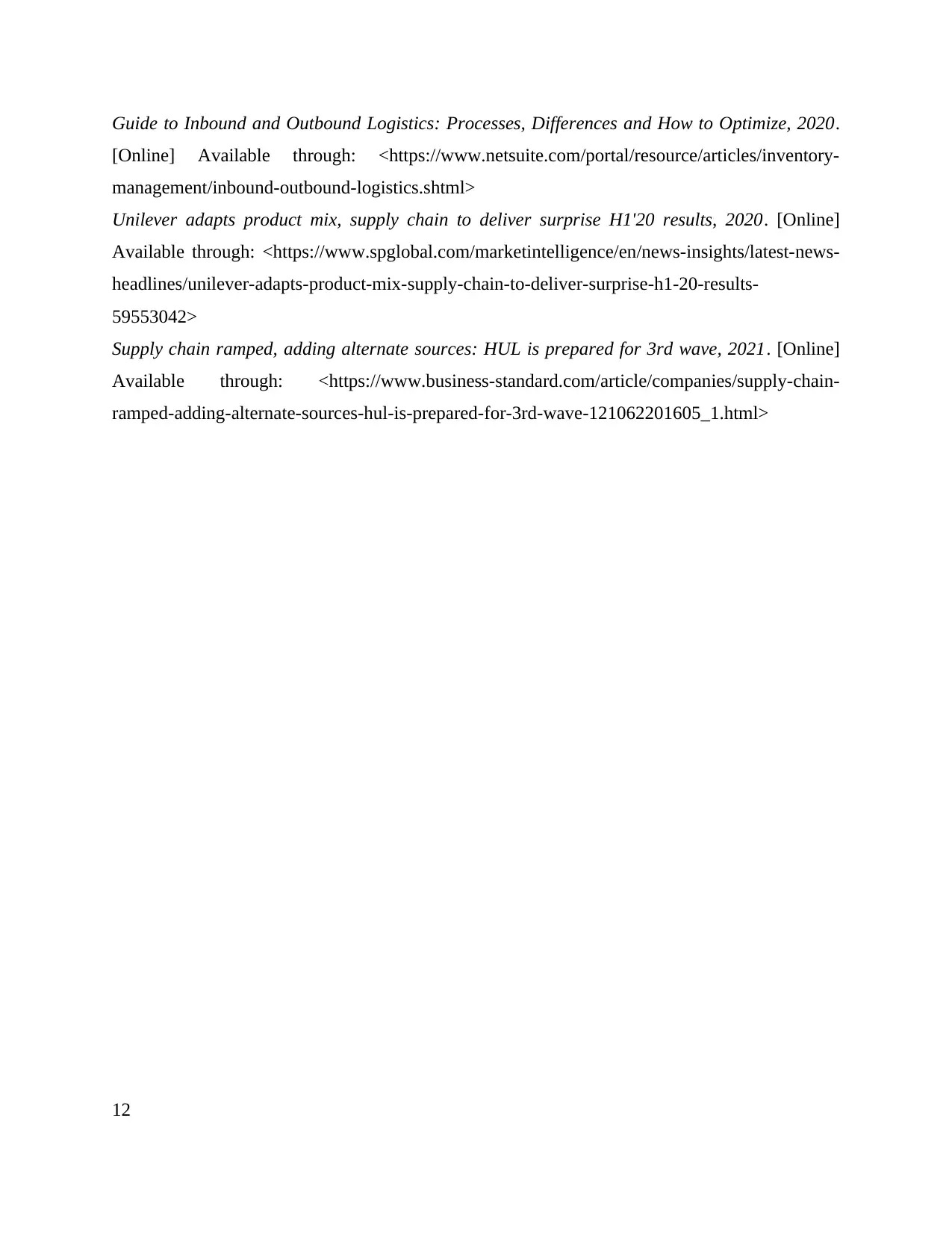
Guide to Inbound and Outbound Logistics: Processes, Differences and How to Optimize, 2020.
[Online] Available through: <https://www.netsuite.com/portal/resource/articles/inventory-
management/inbound-outbound-logistics.shtml>
Unilever adapts product mix, supply chain to deliver surprise H1'20 results, 2020. [Online]
Available through: <https://www.spglobal.com/marketintelligence/en/news-insights/latest-news-
headlines/unilever-adapts-product-mix-supply-chain-to-deliver-surprise-h1-20-results-
59553042>
Supply chain ramped, adding alternate sources: HUL is prepared for 3rd wave, 2021. [Online]
Available through: <https://www.business-standard.com/article/companies/supply-chain-
ramped-adding-alternate-sources-hul-is-prepared-for-3rd-wave-121062201605_1.html>
12
[Online] Available through: <https://www.netsuite.com/portal/resource/articles/inventory-
management/inbound-outbound-logistics.shtml>
Unilever adapts product mix, supply chain to deliver surprise H1'20 results, 2020. [Online]
Available through: <https://www.spglobal.com/marketintelligence/en/news-insights/latest-news-
headlines/unilever-adapts-product-mix-supply-chain-to-deliver-surprise-h1-20-results-
59553042>
Supply chain ramped, adding alternate sources: HUL is prepared for 3rd wave, 2021. [Online]
Available through: <https://www.business-standard.com/article/companies/supply-chain-
ramped-adding-alternate-sources-hul-is-prepared-for-3rd-wave-121062201605_1.html>
12
⊘ This is a preview!⊘
Do you want full access?
Subscribe today to unlock all pages.

Trusted by 1+ million students worldwide
1 out of 12
Related Documents
Your All-in-One AI-Powered Toolkit for Academic Success.
+13062052269
info@desklib.com
Available 24*7 on WhatsApp / Email
![[object Object]](/_next/static/media/star-bottom.7253800d.svg)
Unlock your academic potential
Copyright © 2020–2025 A2Z Services. All Rights Reserved. Developed and managed by ZUCOL.




